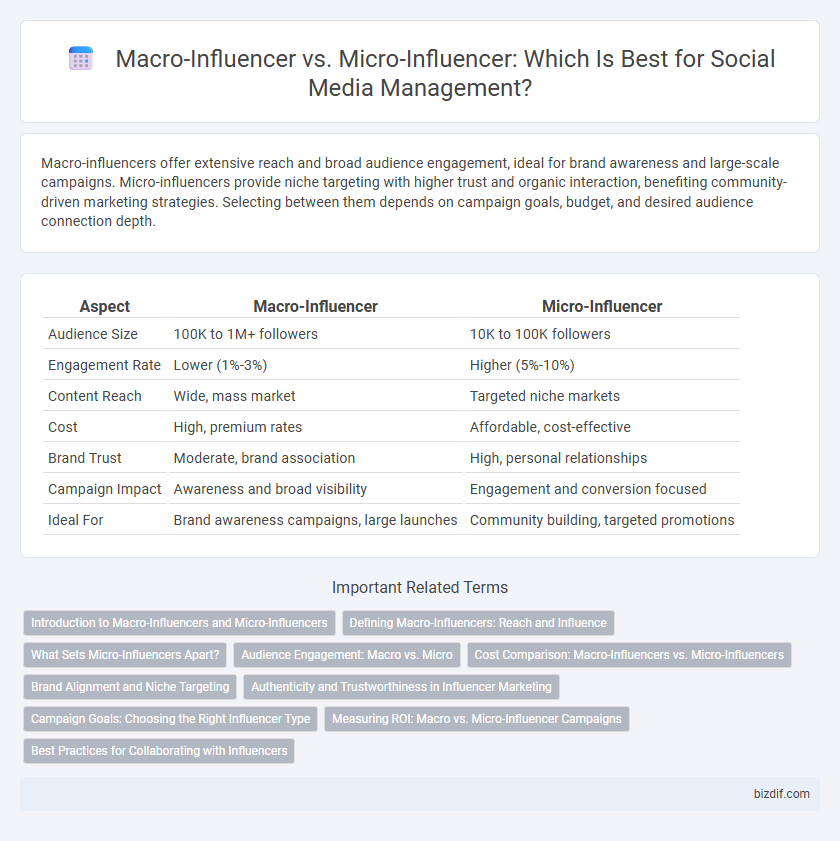Macro-influencers offer extensive reach and broad audience engagement, ideal for brand awareness and large-scale campaigns. Micro-influencers provide niche targeting with higher trust and organic interaction, benefiting community-driven marketing strategies. Selecting between them depends on campaign goals, budget, and desired audience connection depth.
Table of Comparison
| Aspect | Macro-Influencer | Micro-Influencer |
|---|---|---|
| Audience Size | 100K to 1M+ followers | 10K to 100K followers |
| Engagement Rate | Lower (1%-3%) | Higher (5%-10%) |
| Content Reach | Wide, mass market | Targeted niche markets |
| Cost | High, premium rates | Affordable, cost-effective |
| Brand Trust | Moderate, brand association | High, personal relationships |
| Campaign Impact | Awareness and broad visibility | Engagement and conversion focused |
| Ideal For | Brand awareness campaigns, large launches | Community building, targeted promotions |
Introduction to Macro-Influencers and Micro-Influencers
Macro-influencers typically have between 100,000 to 1 million followers, offering broad audience reach and high visibility for brand campaigns. Micro-influencers usually possess 10,000 to 100,000 followers, delivering more niche, engaged communities with higher engagement rates and authentic connections. Choosing between macro-influencers and micro-influencers depends on campaign goals, budget, and desired audience targeting precision.
Defining Macro-Influencers: Reach and Influence
Macro-influencers typically have between 100,000 and 1 million followers, offering a broad reach across diverse audiences. Their influence is characterized by high engagement rates and the ability to drive significant brand awareness on major social media platforms such as Instagram, YouTube, and TikTok. Brands leverage macro-influencers to amplify campaigns, maximize visibility, and connect with a wide spectrum of potential customers.
What Sets Micro-Influencers Apart?
Micro-influencers stand out in social media management due to their highly engaged and niche audiences, often resulting in higher trust and authenticity compared to macro-influencers. Their follower counts typically range from 10,000 to 100,000, enabling more personalized interactions and stronger community ties. Brands leveraging micro-influencers benefit from cost-effective campaigns with increased conversion rates driven by targeted and relevant content.
Audience Engagement: Macro vs. Micro
Micro-influencers typically generate higher audience engagement rates compared to macro-influencers due to their niche followings and authentic connections. Macro-influencers reach larger audiences but often experience lower interaction percentages as their content caters to broader demographics. Brands seeking meaningful engagement often prefer micro-influencers for targeted campaigns and stronger community trust.
Cost Comparison: Macro-Influencers vs. Micro-Influencers
Macro-influencers typically command higher fees, ranging from $10,000 to $100,000 per post, due to their extensive follower base of over 100,000 users and broad reach. Micro-influencers, with audiences between 10,000 and 100,000 followers, offer more cost-effective options, often charging $100 to $1,000 per post, delivering higher engagement rates at a lower price point. Brands seeking targeted marketing with budget constraints frequently prefer micro-influencers for better ROI and niche audience connection.
Brand Alignment and Niche Targeting
Macro-influencers offer extensive reach but may lack precise brand alignment due to their broader audience, while micro-influencers provide stronger niche targeting with higher engagement from specific communities. Brands seeking authentic connections benefit from micro-influencers who resonate deeply within targeted demographics, enhancing campaign relevance. Leveraging micro-influencers allows for tailored messaging that aligns closely with brand values and audience interests, maximizing conversion potential.
Authenticity and Trustworthiness in Influencer Marketing
Macro-influencers boast large followings, but micro-influencers excel in authenticity and trustworthiness due to their closer, niche connections with audiences. Engagement rates for micro-influencers typically surpass those of macro-influencers, fostering genuine interactions that drive brand loyalty. Social media management strategies prioritize micro-influencers to enhance credible influencer marketing campaigns and achieve higher ROI.
Campaign Goals: Choosing the Right Influencer Type
Macro-influencers are ideal for campaigns aiming to maximize brand awareness due to their extensive reach and diverse audience, while micro-influencers excel in driving higher engagement and authentic connections within niche markets. Selecting the right influencer type depends on campaign goals such as broad visibility versus targeted community influence. Brands focusing on conversion and trust often benefit more from micro-influencers' specialized audiences and personalized content.
Measuring ROI: Macro vs. Micro-Influencer Campaigns
Measuring ROI in social media campaigns reveals that macro-influencers offer broader reach and brand visibility, ideal for awareness-focused goals, but often come with higher costs and lower engagement rates per follower. Micro-influencers deliver higher engagement and trust within niche audiences, generating more authentic interactions and often achieving better conversion rates at a lower cost. Brands must analyze campaign objectives and audience demographics to determine whether the expansive impact of macro-influencers or the targeted influence of micro-influencers provides a more efficient return on investment.
Best Practices for Collaborating with Influencers
Macro-influencers, with their extensive reach, are ideal for brand awareness campaigns, while micro-influencers tend to generate higher engagement and trust within niche communities. Best practices for collaborating with influencers include clear communication of campaign goals, authentic content creation, and tracking performance metrics like engagement rates and conversion. Leveraging the unique strengths of each influencer type ensures optimized ROI and brand alignment.
macro-influencer vs micro-influencer Infographic

 bizdif.com
bizdif.com